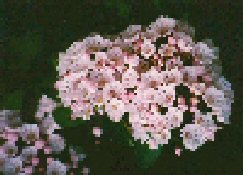
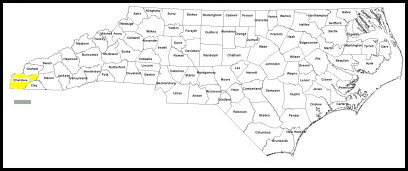

 |  |  |
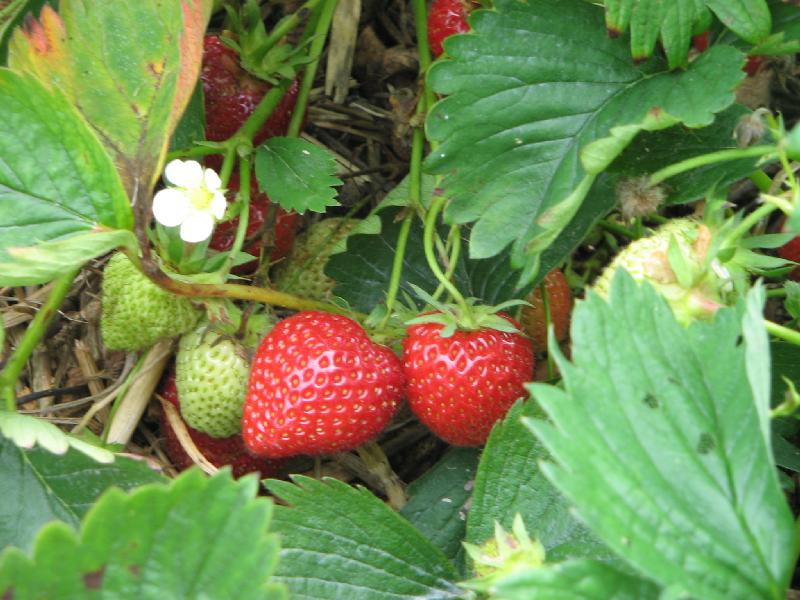  |
State BerriesIn 2001, the General Assembly named the strawberry as the official Red Berry of North Carolina, and named the blueberry as the official Blue Berry of the state (Session laws, 2001, c. 488) Strawberries (genus fraggaria) are high in Vitamin C and A and supply 8% of the RDA for Iron. There are only 60 calories in a cup of fresh berries and 0 grams of fat. A cup of blueberries (genus vaccinium) supplies 50% of the RDA for Vitamin C as well as 22% of the fiber recommended for a healthy diet. The session law itself explains how important these two berries are to the agricultural economy of the state. In the year 2000 strawberries brought in over $17,000,000, while the blueberry created over $18,000,000 in revenues. Both berries are grown throughout the state and consumers can pick their own berries at farms from one end of North Carolina to the other, The NC Department of Agriculture provides a list of pick-your-own farms at NC Farm Fresh. |

| State BeverageThe General Assembly of 1987 adopted milk as the official State Beverage.
|
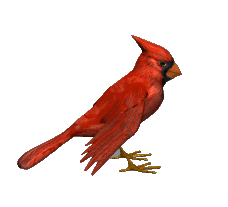  |
State BirdThe Cardinal was selected by popular choice as our State Bird on March 4, 1943. The Cardinal is sometimes called the Winter Redbird because it is most noticeable during the winter when it is the only "redbird" present. A year-round resident of North Carolina, the Cardinal is one of the most common birds in our gardens, meadows, and woodlands. The male Cardinal is red all over, except for the area of its throat and the region around its bill which is black; it is about the size of a Catbird only with a longer tail. The head is conspicuously crested and the large stout bill is red. The female is much duller in color with the red confined mostly to the crest, wings, and tail. This difference in coloring is common among many birds. Since it is the female that sits on the nest, her coloring must blend more with her natural surroundings to protect her eggs and young from predators. There are no seasonal changes in her plumage. The Cardinal is a fine singer, and what is unusual is that the female sings as beautifully as the male. The male generally monopolizes the art of song in the bird world. The nest of the Cardinal is rather an untidy affair built of weed stems, grass and similar materials in low shrubs, small trees or bunches of briars, generally not over four feet above the ground. The usual number of eggs set is three in this State and four further North. Possibly the Cardinal raises an extra brood down here to make up the difference, or possibly the population is more easily maintained here by the more moderate winters compared to the colder North. The Cardinal is by nature a seed eater, but he does not dislike small fruits and insects. |
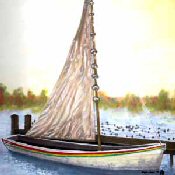 |
State BoatThe General Assembly of 1987 adopted the shad boat as the official State Historical Boat. The Shad Boat was developed on Roanoke Island and is known for its unique crafting and maneuverability. The name is derived from that of the fish it was used to catch - the shad. Traditional small sailing craft were generally ill-suited to the waterways and weather conditions along the coast. The shallow draft of the Shad Boat plus its speed and easy handling made the boat ideal for the upper sounds where the water was shallow and the weather changed rapidly. The boats were built using native trees such as cypress, juniper, and white cedar, and varied in length between twenty-two and thirty-three feet. Construction was so expensive that the production of the Shad Boat ended in the 1930s, although they were widely used into the 1950s. The boats were so well constructed that some, nearly 100 years old, are still seen around Manteo and Hatteras. |
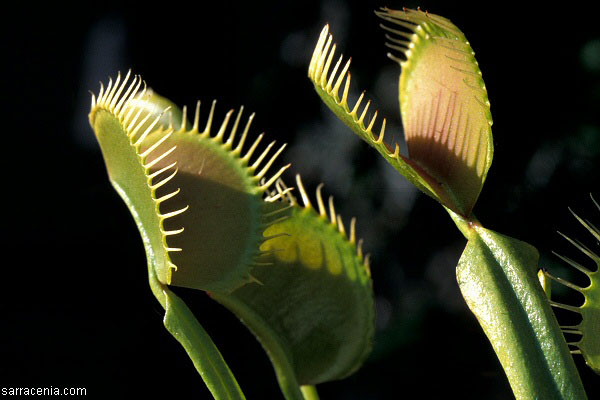 |
State Carnivorous Plant, Venus FlytrapThe General Assembly of 2005 adopted the Venus Flytrap (Dionaea muscipula) as the official State Carnivorous Plant (Session Laws, 2005, c. 74) . The Venus Flytrap is currently listed as a Species of Special Concern, which means, "...any species of plant in North Carolina which requires monitoring but which may be collected and sold under regulations adopted under the provisions of this Article" (NCGS 106-202.12). Though it is known and cultivated throughout the world, it is native only to a small area of the Coastal Plain in North and South Carolina (mostly within a 75 mile radius around Wilmington). The trap is activated when an insect (or other object) brushes 2 or more times against bristles that grow on the surface of the leaf. The trap springs shut in less than a second, but doesn't close completely until it has determined (either chemically or through movement) if it has caught worthwhile food. If it has, the trap gradually seals completely shut, allowing digestion to take place. It reopens in 3 days to 2 weeks. |
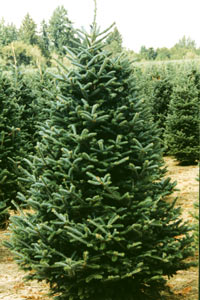 " " |
State Christmas TreeThe General Assembly of 2005 adopted the Fraser Fir as the official Christmas Tree for the State of North Carolina (Session Laws, 2005, c. 387). This law is the result of the hard work of Eighth Grade students at Harris Middle School in Spruce Pine, who researched the economic impact of the Fraser Fir industry on the state, and suggested this species as a new state symbol. The Fraser fir (Abies fraseri) derives its name from John Fraser, a Scottish botanist who explored the Appalachian Mountains in the 1700's, and was a collaborator and competitor with Andre Michaux (see Carolina Lily on this page). Fraser firs, which are native to the Appalachian Mountains, can reach a height of 80 feet and be as much as 18 inches in diameter. The Fraser Fir can take as long as 12 years to grow to retail Christmas Tree height (6-7 feet), and will be visited by the grower more than 100 times during it's life. The Fraser Fir has been chosen 9 times since 1971 (most recently in 2005) as the White House Christmas Tree, and constitutes more than 90% of Christmas tree production in North Carolina. |
 |
State ColorsThe General Assembly of 1945 declared Red and Blue of shades appearing in the North Carolina State Flag and the American Flag as the official State Colors. |
State Dances, Clogging; the Shag The General Assembly of 2005 adopted Clogging as the official folk dance, and Shagging as the official popular dance. (Session Laws, 2005, c. 218) Clogging (the name of which derives from the Gaelic word for "time") is the name of a distinctive dance style which originated in the Appalachian mountains. Settlers from Northern and Western Europe (such as Holland, Germany, and the British Isles) brought their respective folk dance traditions to the colonies, which were further shaped by Native American and African American dance influences. These influences all combined and evolved into a percussive "foot-tapping" style of dance now known as Clogging. In the 1920's, Bascom Lamar Lunsford added team clogging to the competitions held at his annual Mountain Dance and Folk Festival in Asheville, thus helping to establish Clogging as a significant part of Appalachian cultural heritage. The Shag is of much more recent origin, being a type of swing dance that developed in the 1930's and 40's. Shagging, combining nimble footwork with upbeat rhythm and blues (known as Beach music) originated at open air beach parties on the North and South Carolina coasts, and is also the official dance for the State of South Carolina. Note: Several sources were used in compiling this profile, including: Session Law 2005-218 DoubleToe Times: About Clogging State History Guide Resources: Carolina Shag About.com: the Shag |
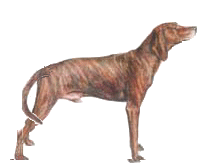 |
State DogThe Plott Hound was officially adopted as our State Dog on August 12, 1989. The Plott Hound breed originated in the mountains of North Carolina around 1750 and is the only breed known to have originated in this State. Named for Jonathan Plott who developed the breed as a wild boar hound, the Plott Hound is a legendary hunting dog known as a courageous fighter and tenacious tracker He is also a gentle and extremely loyal companion to hunters of North Carolina. The Plott Hound is very quick of foot with superior treeing instincts and has always been a favorite of big-game hunters. The Plott Hound has a beautiful brindle-colored coat and a spine-tingling, bugle-like call. It is also only one of four breeds known to be of American origin. |
State Festivals The State of North Carolina has three official festivals. In 1993, the General Assembly adopted the Hertford County Watermelon Festival as the official Northeastern North Carolina Watermelon Festival (Session Laws, 1993, c. 212). In 1993, the General Assembly also designated the Fair Bluff Watermelon Festival as the official Southeastern North Carolina Watermelon Festival (Session Laws, 1993, c. 212). In 2003, the General Assembly designated Folkmoot USA as the official State International Festival (Session Laws, 2003, c. 315). |
 | State FishThe General Assembly of 1971 designated the Channel Bass (Red Drum) as the official State Salt Water Fish. Channel Bass usually occur in great supply along the Tar Heel coastal waters and have been found to weigh up to 75 pounds although most large ones average between 30 and 40 pounds. |
 |
State FlagThe flag is an emblem of antiquity and has commanded respect and reverence from practically all nations from the earliest times. History traces it to divine origin, the early peoples of the earth attributing to it strange, mysterious, and supernatural powers. Indeed, our first recorded references to the standard and the banner, of which our present flag is but a modified form, are from sacred rather than from secular sources. We are told that it was around the banner that the prophets of old rallied their armies and under which the hosts of Israel were led to believing, as they did, that the flag carried with it divine favor and protection. The flags of most of the states, however, consist of the coat of arms of that state upon a suitably colored field. It is said that the first state flag of North Carolina was built on this model but legislative records show that a "state flag" was not established or recognized until 1861. The constitutional convention of 1861, which passed the ordinance of secession, adopted a state flag. On May 20, 1861, the day the secession resolution was adopted, Col. John D. Whitford, a member of the convention from Craven County, introduced an ordinance, which was referred to a select committee of seven. The ordinance stated that "the flag of this State shall be a blue field with a white V thereon, and a star, encircling which shall be the words, Sirgit astrum, May 20, 1775." Colonel Whitford was made chairman of the committee to which this ordinance was referred. The committee secured the aid and advice of William Jarl Browne, an artist of Raleigh. Browne prepared and submitted a model to this committee and this model was adopted by the convention of June 22, 1861. The Browne model was vastly different from the original design proposed by Colonel Whitford. This state flag, adopted in 1861, is said to have been issued to North Carolina regiments of state troops during the summer of 1861 and borne by them throughout the war. It was the only flag, except the national and Confederate colors, used by North Carolina troops during the Civil War. This flag existed until 1885, when the Legislature adopted a new model. It is interesting to examine the significance of the dates found on the flag. The first date, "May 20, 1775," refers to the Mecklenburg Declaration of Independence, although many speculate the authenticity of this particular document. The second date appearing on the state flag of 1861 is that of "May 20th, 1861." This date commemorated the secession of the State from the Union, but as the cause for secession was defeated, this date no longer represented anything after the Civil War. So when a new flag was adopted in 1885, this date was replaced with "April 12th, 1776." This date commemorates the Halifax Resolves, a document that places the Old North State in the very front rank, both in point of time and in spirit, among those that demanded unconditional freedom and absolute independence from any foreign power. This document stands out as one of the great landmarks in the annals of North Carolina history. Since 1885 there has been no change in our state flag. For the most part, it has remained unknown and a stranger to the good people of our State. However, as we became more intelligent, and therefore, more patriotic and public spirited, the emblem of the Old North State assumed a station of greater prominence among our people. One hopeful sign of this increased interest was the act passed by the Legislature of 1907, requiring the state flag to be floated from all state institutions, public buildings, and courthouses. In addition to this, many public and private schools, fraternal orders, and other organizations now float the state flag. |
 |
State FlowerThe General Assembly of 1941 designated the dogwood as the State Flower. The Dogwood is one of the most prevalent trees in our State and can be found in all parts of the State from the mountains to the coast. Its blossoms, which appear in early spring and continue on into summer, are most often found in white, although shades of pink (red) are not uncommon. |

 | State FruitThe General Assembly of 2001 named the Scuppernong grape as the official State Fruit (Session laws, 2001, c. 488). The Scuppernong (vitis rotundifolia) is a variety of muscadine grape, and has the distinction of being the first grape ever actively cultivated in the United States. It was named for the Scuppernong River, which runs from Washington County to the Albemarle Sound. Giovanni de Verrazano noticed this variety as far back as 1524, and explorers for Sir Walter Raleigh (or Ralegh, as it's sometimes spelled) in the 1580’s sent back reports from the Outer Banks of grape vines that “…covered every shrub and climbed the tops of high cedars. In all the world, a similar abundance was not to be found.” The Roanoke colonists are credited with discovering the Scuppernong “Mother Vineyard,” a vine that is now over 400 years old and covers half an acre. Grape cultivation (of scuppernong and other varieties) is a small but growing part of the North Carolina economy. The value of the state’s 2000 crop was over $2,600,000, up 17% from 1999. According to the NC Department of Agriculture, there are 250 vineyards and 25 wineries located throughout the state. |
 |
State InsectThe General Assembly of 1973 designated the Honey Bee as the official State Insect. This industrious creature is responsible for the annual production of more than $2 million worth of honey in the state. However, the greatest value of Honey Bees is their role in the growing cycle as a major contributor to the pollination of North Carolina crops. |
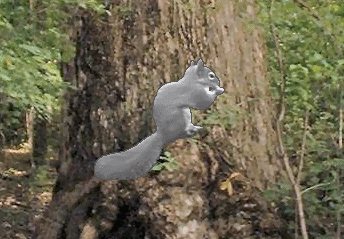 |
State MammalThe General Assembly of 1969 designated the Gray Squirrel as the official State Mammal. The gray squirrel is a common inhabitant of most areas of North Carolina from "the swamps of eastern North Carolina to the upland hardwood forests of the piedmont and western counties." He feels more at home in an "untouched wilderness" environment, although many squirrels inhabit our city parks and suburbs. During the fall and winter months the gray squirrel survives on a diet of hardwoods, with acorns providing carbohydrates and proteins. In the spring and summer, their diet consists of "new growth and fruits" supplemented by early corn, peanuts, and insects. |
 |
"The Old North State or The Tar Heel State"In 1629, King Charles I of England "erected into a province," all the land from Albemarle Sound on the north to the St. John's River on the south, which he directed should be called Carolina. The word Carolina is from the word Carolus, the Latin form of Charles. When Carolina was divided in 1710, the southern part was called South Carolina and the northern, or older settlement, North Carolina. From this came the nickname the "Old North State." Historians have recorded that the principle products during the early history of North Carolina were "tar, pitch, and turpentine." It was during one of the fiercest battles of the War Between the States, so the story goes, that the column supporting the North Carolina troops was driven from the field. After the battle the North Carolinians, who had successfully fought it out alone, were greeted from the passing derelict regiment with the question: "Any more tar down in the Old North State, boys?" Quick as a flash came the answer: "No, not a bit, old Jeff's bought it all up." "Is that so; what is he going to do with it?" was asked. "He's going to put on you-un's heels to make you stick better in the next fight." Creecy relates that General Lee, upon hearing of the incident, said: "God bless the Tar Heel boys," and from that they took the name. |
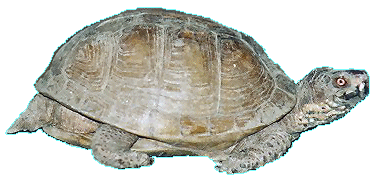 | State ReptileThe General Assembly of 1979 designated the Eastern Box Turtle as the official State Reptile for North Carolina. The turtle is one of nature's most useful creatures. Through its dietary habits it serves to assist in the control of harmful and pestiferous insects and as a clean-up crew, helping to preserve the purity and beauty of our waters. At a superficial glance, the turtle appears to be a mundane and uninteresting creature; however, closer examination reveals it to be most fascinating, ranging from species well-adapted to modern conditions to species which have existed virtually unchanged since prehistoric times. Derided by many, the turtle is really a culinary delight, providing the gourmet food enthusiast with numerous tasty dishes from soups to entrees. The turtle watches undisturbed as countless generations of faster "hares" run by to quick oblivion, and is thus a model of patience for mankind, and a symbol of our State's unrelenting pursuit of great and lofty goals. |
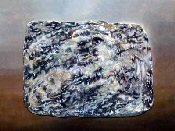 | State RockThe General Assembly of 1979 designated Granite as the official Rock for the State of North Carolina. The State of North Carolina has been blessed with an abundant source of "the noble rock," granite. Just outside Mount Airy in Surry County is the largest open face granite quarry in the world measuring one mile long and 1,800 feet in width. The granite from this quarry is unblemished, gleaming, and without interfering seams to mar its splendor. The high quality of this granite allows its widespread use as a building material, in both industrial and laboratory applications where supersmooth surfaces are necessary. North Carolina granite has been used for many magnificent edifices of government throughout the United States such as the Wright Brothers Memorial at Kitty Hawk, the gold depository at Fort Knox, the Arlington Memorial Bridge and numerous courthouses throughout the land. Granite is a symbol of strength and steadfastness, qualities characteristic of North Carolinians. It is fitting and just that the State recognize the contribution of granite in providing employment to its citizens and enhancing the beauty of its public buildings. |
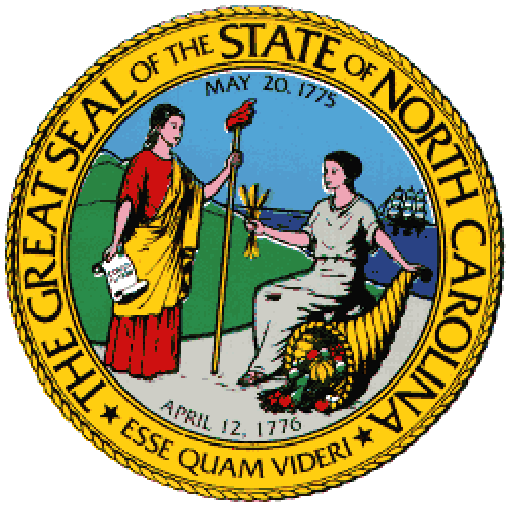 | State Seal and State MottoA seal for important documents was used before the government was ever implemented in North Carolina. During the colonial period North Carolina used successively four different seals. Since independence, six seals have been used. Shortly after King Charles II issued the Charter of 1663 to the Lords Proprietors, a seal was adopted to use in conjunction with their newly acquired domains in America. No official description has been found of the seal but it can be seen in the British Public Record Office in London. The seal had two sides and was three and three-eighths inches in diameter. The impression was made by bonding two wax cakes together with tape before being impressed. The finished impression was about one-fourth inch thick. This seal was used on all official papers of the Lords Proprietors of Carolina, embracing both North Carolina and South Carolina. When the Government of Albemarle was organized in 1665, it adopted for a seal the reverse side of the seal of the Lords Proprietors. Between the coat-of-arms, the word A-L-BE-M-A-R-L-E was fixed in capitals, beginning with the letter "A" between the Craven arms and those of Lord John Berkeley. The Albemarle seal was small, only one and seven-sixteenths inches in diameter and had only one face. The seal was usually impressed on red wax, but was occasionally seen imprinted on a wafer stuck to the instrument with soft wax. The government for Albemarle County was the first to use the seal; however, as the colony grew, it became the seal of the entire Province of North Carolina. It continued in use until just after the purchase of North Carolina by the crown. During the troublesome times of the Cary Rebellion, the Albemarle seal was not used. Instead, Cary used his family arms as seal for official papers. William Glover used his private seal during his presidency as well. When North Carolina became a Royal Colony in 1729, the old "Albemarle" seal was no longer applicable. On February 3, 1730, the Board of Trade recommended that the king order a public seal for the Province of North Carolina. Later that same month, the king approved the recommendations and ordered that a new seal be prepared for the Governor of North Carolina. On March 25, the Board of Trade presented the king with a draft of the proposed seal for his consideration. The king approved the proposed new seal on April 10 with one minor change - "Georgius Secundus" was to be substituted for the original "Geo.II." The chief engraver of seals, Rollos, was ordered to "engrave a silver Seal according to said draught ...." The arrival of the new seal in North Carolina was delayed, so when the council met in Edenton on March 30, 1731, the old seal of the Colony was ordered to be used till the new seal arrived. The new seal arrived in late April and the messenger fetching the seal from Cape Fear was paid ten pounds for his journey. The impression of the new seal was made by placing two cakes or layers of wax together, and then interlacing ribbon or tape with the attached seal between the wax cakes. It was customary to put a piece of paper on the outside of three cakes before they were impressed. The complete seal was four and three-eighths inches in diameter and from one-half to five-eighths inches thick and weighed about five and one-half ounces. At a meeting of the council held in New Bern on December 14, 1767, Governor Tryon produced a new Great Seal of the province with his Majesty's Royal Warrant bearing date at the Court of St. James the 9th day of July, 1767. The old seal was returned to his Majesty's Council office at Whitehall in England. Accompanying the warrant was a description of the new seal with instruction that the seal was to be used in sealing all patents and grants of lands and all public instruments passed in the king's name for service within the province. It was four inches in diameter, one-half to five-eighths inches thick, and weighed four and one-half ounces. Sometimes a smaller seal than the Great Seal was used on commissions and grants, such as a small heart-shaped seal, or a seal in the shape of an ellipse. These impressions were evidently made by putting the wax far enough under the edge of the Great Seal to take the impression of the crown. The royal governors also used their private seals on commissions and grants. Lord Granville, after the sale of the colony by the Lords Proprietors, retained his right to issue land grants. He used his private seal on the grants he issued. The last reference found to the colonial seal is in a letter from Governor Martin to the Earl of Hillsborough in November, 1771, in which he recounts the broken condition of the seal. He states the seal had been repaired and though "awkwardly mended . . . [it was] in such manner as to answer all purposes." Following independence Section XVII of the new constitution adopted at Halifax on December 18, 1776, provided "That there shall be a Seal of this State, which shall be kept by the Governor, and used by him as occasion may require; and shall be called the Great Seal of the State of North Carolina, and be affixed to all grants and commissions." When a new constitution was adopted in 1868, Article III, Section 16 provided for ". . . a seal of the State, which shall be kept by the Governor, and used by him, as occasion may require, and shall be called 'The Great Seal of the State of North Carolina.' It also provided for the secretary of state to countersign with the governor. When the people of North Carolina ratified the current constitution in 1970, Article III, Section 10 contained provisions for "The Great Seal of the State of North Carolina." However, the wording which authorized the secretary of state to countersign documents was removed. On December 22, 1776, the Provincial Congress at Halifax appointed William Hooper, Joseph Hewes and Thomas Burke as commissioners to procure a seal for the State; however, there is no record that a report was ever made by this commission. The Congress provided for the governor to use his "private seal at arms" until the Great Seal for the state was procured. A bill calling for the procurement of a Great Seal was introduced in the lower house of the General Assembly on April 28, 1778. The bill became law on May 2. The legislation provided that William Tisdale, Esq., be appointed to cut and engrave a seal for the State. On Sunday, November 7, 1779, the senate granted Tisdale £150 to make the seal. The seal procured under this act was used until 1794. The actual size of the seal was three inches in diameter and one-fourth inch thick. It was made by putting two cakes of wax together with paper wafers on the outside and pressing them between the dies, thus forming the obverse and reverse sides of the seal. An official description of this seal cannot be found, but many of the seals still in existence are in an almost perfect state of preservation. In January, 1792, the General Assembly authorized a new State seal, requiring that it be prepared with only one side. Colonel Abisha Thomas, an agent of North Carolina commissioned by Governor Martin, was in Philadelphia to settle the State's Revolutionary claims against the Federal Government. Martin sent a design to Colonel Thomas for a new seal for the State; however, after suggestions by Dr. Hugh Williamson and Senator Samuel Johnston, this sketch was disregarded and a new one submitted. This new sketch, with some modification, was finally accepted by Governor Spaight, and Colonel Thomas had the seal made accordingly. The seal press for the old seal must have been very large and unwieldy probably due to the two-sided nature and large diameter of the seal. Governor Richard Dobbs Spaight in a letter to Colonel Abisha Thomas in February, 1793, wrote: "Let the screws by which the impression is to be made be as portable as possible so as it may be adapted to our present itinerant government. The one now in use by which the Great Seal is at present made is so large and unwieldy as to be carried only in a cart or wagon and of course has become stationary at the Secretary's office which makes it very convenient." The seal was cut some time during the summer of 1793, and Colonel Thomas brought it home with him in time for the meeting of the legislature in November, 1793, at which session it was "approbated." The screw to the seal was two and one half inches in diameter and was used until around 1835. In the winter of 1834-35 the legislature enacted legislation authorizing the governor to procure a new seal. The preamble to the act stated that the old seal had been used since the first day of March, 1793. A new seal which was very similar to its predecessor was adopted in 1835 and continued in use until 1893. In 1868 the legislature authorized the governor to procure a new replacement Seal and required him to do so whenever the old one was lost or so worn or defaced that it was unfit for use. In 1883, Colonel S. MCD. Tate introduced a bill that did not provide that a new seal be procured but described in more detail what the seal should be like In 1893, Jacob Battle introduced a bill that made no change in the seal except to add at the foot of the coat-of-arms of the state as part thereof the motto Esse Quam Videri and to provide that the words "May 20, 1775," be inscribed at the top of the coat-of-arms. By the late 19th and early 20th century, the ship that appeared in the background of the early seals had disappeared. The North Carolina Mountains were the only backdrop on the seal, while formerly both the mountains and the ship had been depicted. This brief history of the seals of our State illustrates the great variety and liberty that was taken in the design of the official State seal. State MottoThe General Assembly of 1893 (chapter 145) adopted the words "Esse Quam Videri" as the State's motto and directed that these words with the date "20 May, 1775," be placed with our Coat of Arms upon the Great Seal of the State. The words "Esse Quam Videri" mean "to be rather than to seem." Nearly every State has adopted a motto, generally in Latin. The reason for mottoes being in Latin is that the Latin language is far more condensed and terse than the English. The three words, "Esse Quam Videri," require at least six English words to express the same idea. It is somewhat unique that until the act of 1893 the sovereign State of North Carolina had no motto since its declaration of independence. It was one of the few states which did not have a motto and the only one of the original thirteen without one. |
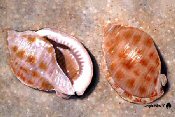 | State ShellThe General Assembly of 1965 designated the Scotch Bonnet (pronounced bonay) as the State Shell. A colorful and beautifully shaped shell, the Scotch Bonnet is abundant in North Carolina coastal waters at depths between 500 and 200 feet. The best source of live specimens is from offshore commercial fishermen. |
 | State SongThe song known as "The Old North State" was adopted as the official song of the State of North Carolina by the General Assembly of 1927. (William Gaston; Collected and Arranged by Mrs. E. E. Randolph)
|
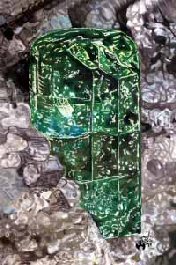 | State GemstoneThe General Assembly of 1973 designated the emerald as the official State Precious Stone. A greater variety of minerals, more than 300, have been found in North Carolina than in any other state. These minerals include some of the most valuable and unique gems in the world. The largest Emerald ever found in North Carolina was 1,438 carats and was found at Hiddenite, near Statesville. The "Carolina Emerald," now owned by Tiffany & Company of New York was also found at Hiddenite in 1970. When cut to 13.14 carats, the stone was valued at the time at $100,000 and became the largest and finest cut emerald on the continent. |
State ToastThe Tar Heel ToastThe following toast was officially adopted as the State Toast of North Carolina by the General Assembly of 1957. (Session Laws, 1957, c. 777). The summer land where the sun doth shine, Where the weak grow strong and the strong grow great, Here's to "Down Home," the Old North State! Here's to the land of the cotton bloom white, Where the scuppernong perfumes the breeze at night, Where the soft southern moss and jessamine mate, 'Neath the murmuring pines of the Old North State! Here's to the land where the galax grows, Where the rhododendron's rosette glows, Where soars Mount Mitchell's summit great, In the "Land of the Sky," in the Old North State! Here's to the land where maidens are fair, Where friends are true and cold hearts rare, The near land, the dear land, whatever fate, The blest land, the best land, the Old North State!
by The JavaScript Source
Some of the animated graphics are from: Wilson's Free Gifs & Animations |